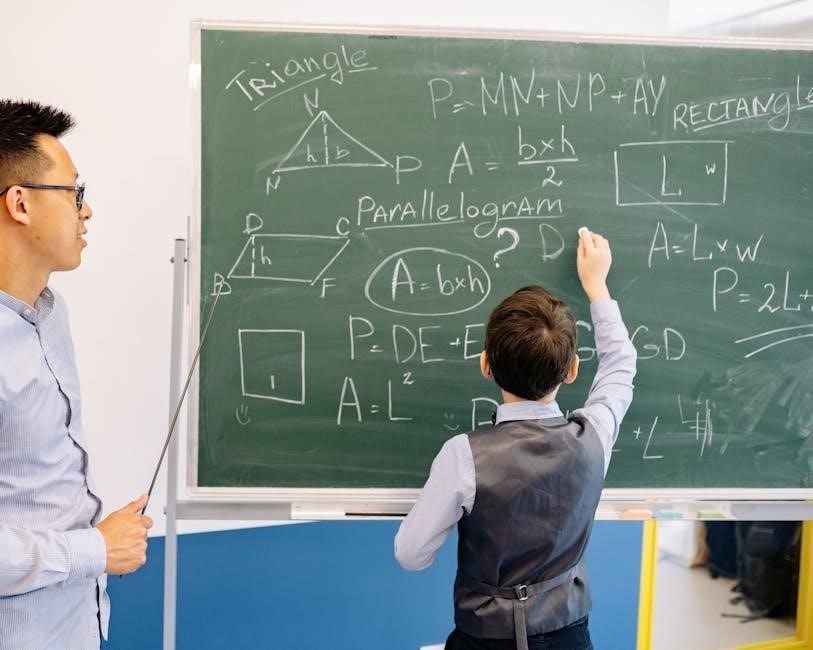
Overview of the Instructional Core Concept
The Instructional Core, defined by Richard Elmore, is the dynamic relationship between teachers, students, and content, emphasizing their interdependence in the learning process.
1.1 Definition of the Instructional Core by Richard Elmore
Richard Elmore defines the Instructional Core as the dynamic relationship between teachers, students, and content. He emphasizes that this core is the foundation of effective instruction, where teaching and learning occur in the presence of subject matter. Elmore argues that improving instruction requires focusing on these three essential elements and their interactions. His work highlights the importance of understanding how teachers, students, and content interrelate to create meaningful learning experiences. This definition underscores the centrality of instruction in education and provides a framework for analyzing and enhancing teaching practices.
1.2 Historical Context and Development of the Concept
The Instructional Core concept emerged from Richard Elmore’s work in educational research and policy. He developed this framework to address the gap between educational theory and classroom practice. Drawing from his studies on teaching effectiveness and school improvement, Elmore emphasized the interplay between teachers, students, and content as the heart of education. His work built on earlier theories of instructional design but introduced a more dynamic view, focusing on relationships rather than isolated components. Over time, the concept has evolved to remain a cornerstone in discussions about educational reform and effective teaching strategies.

Key Components of the Instructional Core
The Instructional Core consists of three essential elements: the teacher, the student, and the content. These components interact dynamically to facilitate effective learning.
2.1 The Role of the Teacher in the Instructional Core
The teacher plays a central role in the Instructional Core by guiding students’ engagement with content. They create learning environments, deliver instruction, and assess understanding. Teachers must possess deep content knowledge and pedagogical skills to adapt instruction to student needs, fostering meaningful interactions. Their expertise ensures that content is accessible and relevant, while their support helps students build connections and apply knowledge. Effective teaching within the Instructional Core demands a balance of subject mastery and student-centered practices to maximize learning outcomes.
2.2 The Role of the Student in the Instructional Core
Students are active participants in the Instructional Core, engaging with content and applying their knowledge to achieve learning goals. Their role involves not only absorbing information but also thinking critically, forming connections, and constructing meaning. Students bring diverse backgrounds and learning styles, requiring teachers to tailor instruction to meet individual needs. Their ability to process and retain information depends on how content is delivered and the support provided. Ultimately, students’ engagement and accountability for high-level thinking and understanding are essential for the Instructional Core to function effectively.
2.3 The Role of Content in the Instructional Core
Content serves as the foundation of the Instructional Core, providing the subject matter that teachers deliver and students learn. It must be relevant, rigorous, and aligned with learning goals to ensure academic success. High-quality content enables deep understanding and critical thinking, while poorly designed material can hinder learning. Effective content also considers diverse learning needs, ensuring accessibility for all students. Teachers must possess expertise in the content to deliver it effectively, making content a crucial element in shaping instructional interactions and student outcomes within the Instructional Core framework.

The Dynamic Relationship Between Teacher, Student, and Content
The Instructional Core highlights the interdependent relationship between teacher, student, and content, where each element influences and shapes the learning process dynamically.
3.1 How Teachers and Students Interact in the Presence of Content
In the Instructional Core, teachers and students interact through content, with teachers guiding students to engage deeply with material. This interaction is dynamic, as teachers adapt instruction based on student responses, ensuring content is accessible and meaningful. Students, in turn, actively process information, applying their prior knowledge and skills. The presence of content serves as a catalyst for dialogue, questioning, and critical thinking, fostering a collaborative learning environment where both teacher and student roles evolve to meet the demands of the subject matter. This interplay is central to effective instruction and student learning outcomes.
3.2 The Importance of Content in Shaping Instructional Interactions
Content is the foundation of the Instructional Core, shaping how teachers and students interact. High-quality, relevant content ensures that instruction is focused and meaningful, guiding teachers in designing lessons that align with learning goals. It also engages students by connecting to their interests and prior knowledge. Without robust content, instructional interactions risk becoming disjointed or superficial. Richard Elmore emphasizes that content provides the context for dialogue and critical thinking, making it essential for fostering deep understanding and academic achievement. Thus, content is not just information but the catalyst for transformative teaching and learning experiences.
3.3 Balancing Teacher Expertise and Student Needs
Balancing teacher expertise and student needs is crucial for effective instruction. Teachers bring deep content knowledge and instructional strategies, while students arrive with diverse backgrounds, skills, and learning requirements. Richard Elmore highlights that teachers must adapt their expertise to meet individual student needs, ensuring learning is accessible and meaningful. This balance requires teachers to be flexible and responsive, using their knowledge to scaffold learning experiences that cater to varied abilities. When achieved, this balance fosters engagement, understanding, and academic growth, making it a cornerstone of the Instructional Core. It ensures that instruction is both rigorous and inclusive.

The Importance of Focusing on Instruction
Focusing on instruction is critical as it directly impacts student learning and academic achievement. Effective instruction ensures the teacher, student, and content work cohesively to achieve learning goals.
4.1 Why Instructional Core is Critical for Student Learning
The Instructional Core is vital for student learning as it connects teachers, students, and content dynamically. This relationship ensures that learning is meaningful and aligned with goals. By focusing on these elements, educators create environments where students engage deeply with material, fostering understanding and retention. Richard Elmore emphasizes that without this core, educational efforts may lack direction and impact; Thus, prioritizing the Instructional Core is essential for maximizing student outcomes and achieving academic success.
4.2 The Impact of Instructional Core on Academic Achievement
The Instructional Core significantly influences academic achievement by fostering a dynamic interplay between teachers, students, and content. When these elements align, students engage more deeply with material, leading to improved understanding and retention. Richard Elmore’s framework highlights that the quality of instruction, not just content, drives learning outcomes. Schools that prioritize the Instructional Core often see higher academic performance, as it ensures teaching practices are intentional and student-centered. This focus on core interactions creates a foundation for meaningful learning, ultimately enhancing overall academic success and preparing students for future challenges. Effective implementation of the Instructional Core is essential for achieving measurable improvements in achievement.
4.3 Aligning Instructional Core with Learning Goals
Aligning the Instructional Core with learning goals ensures that teaching practices, student engagement, and content relevance work cohesively toward desired outcomes. Richard Elmore emphasizes that when the instructional core is purposefully connected to clear learning objectives, it enhances the effectiveness of instruction. This alignment ensures that teachers deliver content in ways that meet student needs, fostering deeper understanding and skill development. By integrating content expertise with adaptive teaching strategies, educators can better support students in achieving both short-term and long-term academic goals, creating a focused and impactful learning environment that prioritizes student success and growth.

Practical Applications of the Instructional Core
The Instructional Core’s practical applications involve aligning teaching practices, student engagement, and content delivery to create effective learning environments, fostering improved academic outcomes and teacher-student interactions.
5;1 Strategies for Teachers to Enhance the Instructional Core
Teachers can enhance the Instructional Core by aligning content with student needs, using active learning techniques, and employing formative assessments to monitor progress. Fostering collaborative environments, encouraging inquiry-based learning, and integrating technology to enrich content delivery are also effective strategies. Professional development and peer collaboration help teachers refine their instructional practices, ensuring they are well-equipped to meet diverse student needs. By focusing on these strategies, educators can create engaging and impactful learning experiences that strengthen the dynamic relationship between teachers, students, and content.
5.2 School Leadership’s Role in Supporting the Instructional Core
School leaders play a crucial role in fostering a professional culture that prioritizes the Instructional Core. They must establish internal systems to monitor and improve teaching practices, ensuring alignment with learning goals. Leaders should promote collaboration among teachers, provide resources for professional development, and create environments where teacher expertise is valued. By prioritizing instructional quality and fostering a growth mindset, leaders can empower teachers to enhance the dynamic relationship between students, content, and instruction. Effective leadership ensures that schools have the structures and support needed to sustain high-quality teaching and learning.
5.3 Professional Development for Improving the Instructional Core
Professional development is essential for enhancing the Instructional Core, focusing on teacher expertise and student needs. Training programs should emphasize understanding content, effective teaching strategies, and student learning dynamics. Collaborative learning opportunities allow educators to share practices and refine their skills. By fostering a growth mindset, professional development ensures teachers can adapt to diverse learning environments and integrate new technologies. Continuous improvement in instructional practices strengthens the teacher-student-content relationship, ultimately benefiting student outcomes and academic achievement. Effective PD aligns with school goals, ensuring sustainable growth in teaching quality.
Implementing the Instructional Core faces challenges like teacher content knowledge gaps, varying student needs, and systemic barriers, requiring tailored solutions to bridge theory and practice effectively. Common barriers include teacher content knowledge gaps, classroom management challenges, and lack of professional development. Additionally, varying student learning needs, resource limitations, and inconsistent school support hinder effective implementation. These obstacles often create a disconnect between theoretical frameworks and practical application, making it difficult to establish a cohesive instructional environment. Addressing these barriers requires targeted professional development, improved resource allocation, and stronger school leadership to ensure teachers and students can thrive within the instructional core framework. Bridging the gap between theory and practice requires aligning instructional core principles with practical application. Professional development programs can help teachers connect theoretical knowledge to classroom practices. School leaders must establish clear expectations and provide resources to support teacher implementation. Additionally, fostering collaborative environments where educators share strategies and reflect on practices can enhance the practical application of the instructional core; By integrating theory into actionable steps, schools can ensure that the instructional core is both understood and effectively implemented, leading to improved teaching and learning outcomes. Collaboration and a strong professional culture are essential for overcoming challenges in implementing the instructional core. Schools must foster environments where teachers and leaders work together, sharing strategies and resources. Professional development opportunities, such as peer learning and mentoring, can strengthen teacher expertise. A culture of collective responsibility and continuous improvement ensures that challenges are addressed collectively. By building trust and fostering open communication, schools can create a supportive environment for both teachers and students, enabling the instructional core to thrive and lead to meaningful learning outcomes. A strong professional culture fosters collaboration, shared goals, and continuous improvement, enabling educators to grow and enhance instructional practices effectively. Building a collaborative school environment involves fostering shared goals, trust, and open communication among teachers, leaders, and staff. Collaboration encourages the exchange of ideas, resources, and expertise, creating a culture where educators collectively focus on improving instruction and student learning. Professional Learning Communities (PLCs) and peer observations are effective strategies to promote collaboration. When teachers work together, they can align their practices with the Instructional Core, ensuring a coherent approach to teaching and learning. A collaborative environment also supports teacher growth, as educators learn from one another and share innovative strategies. This collective effort enhances the overall quality of education. Internal systems in schools are crucial for establishing a structured and coherent approach to instruction and student learning. These systems ensure consistency in teaching practices, alignment with curriculum goals, and accountability for educational outcomes. Strong internal systems enable schools to monitor progress, identify areas for improvement, and provide targeted support. They also facilitate professional development and collaboration among educators. According to Richard Elmore, schools must develop their own internal systems to ensure high-quality instruction and create a professional culture focused on continuous improvement. Effective internal systems are essential for achieving the full potential of the instructional core. Fostering a growth mindset among educators is essential for improving the instructional core. A growth mindset encourages teachers to view challenges as opportunities for development rather than obstacles. Richard Elmore emphasizes that educators who embrace this mindset are more likely to innovate, reflect on their practices, and seek continuous improvement. Schools can promote this by providing professional development opportunities, encouraging collaboration, and creating a supportive culture where risks are embraced as part of the learning process. By fostering a growth mindset, educators can better adapt to student needs, enhance their teaching strategies, and contribute to a more dynamic and effective learning environment. Real-world applications of the instructional core demonstrate its effectiveness in improving teaching and learning. Successful schools showcase how aligning teacher expertise, student engagement, and content leads to enhanced academic outcomes. Successful schools have implemented the instructional core by focusing on the dynamic interaction between teachers, students, and content. For instance, schools that prioritize teacher expertise, student engagement, and relevant content have seen measurable improvements in academic performance. Professional development programs and collaborative teaching practices have been key strategies. These real-world examples highlight how aligning instruction with learning goals fosters a growth mindset among educators and students alike, leading to sustainable educational improvement. Such applications demonstrate the practical value of Richard Elmore’s framework in enhancing teaching and learning outcomes. Successful schools demonstrate that establishing internal systems and professional cultures is crucial for improving instruction. They align teaching practices with learning goals, fostering a growth mindset among educators and students. Collaborative environments, teacher expertise, and content relevance are key priorities. These schools emphasize professional development and structured feedback mechanisms. By focusing on the instructional core, they create sustainable improvements in academic achievement. These lessons highlight the importance of intentional planning and a commitment to continuous improvement in education. Such approaches underscore Richard Elmore’s vision of enhancing teaching and learning through targeted, evidence-based strategies. Measuring the impact of instructional core strategies involves assessing student learning outcomes, teacher effectiveness, and content alignment. Schools use metrics like academic performance, engagement levels, and progress monitoring to evaluate success. Longitudinal studies and comparative analyses help identify sustained improvements. Feedback from educators and students provides qualitative insights, while standardized assessments offer quantitative data. By aligning evaluation methods with instructional goals, schools can determine the effectiveness of their strategies and make data-driven adjustments. This approach ensures that the instructional core remains a dynamic and responsive framework for enhancing teaching and learning. Continuous measurement fosters accountability and drives meaningful educational improvements. The future of the instructional core involves integrating technology, fostering personalized learning, and adapting to diverse educational environments while maintaining its foundational focus on teacher-student-content dynamics. Emerging trends in instructional core practices include the integration of technology, personalized learning, and adaptive teaching strategies. These trends emphasize real-time feedback, data-driven instruction, and culturally responsive teaching. Educators are leveraging digital tools to enhance the teacher-student-content dynamic, making learning more engaging and accessible. Additionally, there is a growing focus on competency-based progression, allowing students to advance at their own pace. These innovations aim to create a more inclusive and effective educational environment, aligning with the foundational principles of the instructional core while addressing modern learning needs. Technology plays a pivotal role in enhancing the instructional core by fostering deeper teacher-student-content interactions. Digital tools provide personalized learning experiences, enabling teachers to tailor instruction to individual needs. Platforms like adaptive learning software and virtual classrooms facilitate real-time feedback, improving student engagement and understanding. Technology also enriches content delivery, making complex concepts more accessible through multimedia resources. Furthermore, it supports collaboration, allowing educators to share best practices and students to work together remotely. By integrating technology, the instructional core becomes more dynamic, flexible, and effective in meeting diverse learning demands while preserving its fundamental principles. The instructional core must adapt to diverse learning environments to ensure equitable education. By understanding individual student needs, teachers can modify content delivery and interactions. Technology aids in personalizing instruction, while culturally responsive practices ensure relevance. Collaborative professional cultures among educators foster innovative strategies tailored to different settings. This adaptability maintains the core’s integrity while addressing varied contexts, ensuring all students benefit from meaningful teacher-student-content interactions. Effective adaptation requires continuous professional development and a growth mindset among educators to meet the challenges of diverse learning environments successfully. The instructional core remains a cornerstone of effective education, emphasizing the dynamic teacher-student-content relationship. Its principles continue to guide educators in fostering meaningful learning experiences. The instructional core, as defined by Richard Elmore, centers on the dynamic relationship between teachers, students, and content. It emphasizes the interdependence of these three elements in fostering effective learning. The teacher plays a pivotal role in guiding instruction, while students actively engage with content to construct meaning. Elmore’s framework underscores the importance of professional culture, internal systems, and continuous improvement in schools. By focusing on these elements, educators can enhance instructional practices, align teaching with learning goals, and create environments that support academic achievement and personal growth for all students. This approach remains foundational for advancing education. The instructional core, as conceptualized by Richard Elmore, remains a cornerstone of effective education. Its focus on the interplay between teacher, student, and content ensures its timeless relevance. By prioritizing these elements, schools can adapt to evolving educational needs while maintaining high standards of teaching and learning. Elmore’s framework continues to guide educators in fostering meaningful interactions and aligning instruction with student growth. Its enduring relevance lies in its ability to address the complexities of modern education, emphasizing the importance of professional culture and internal systems to sustain improvement and innovation in the classroom. This ensures the instructional core remains vital.
Challenges in Implementing the Instructional Core
6.1 Common Barriers to Effective Instructional Core Practices
6.2 Addressing the Gap Between Theory and Practice
6.3 Overcoming Challenges Through Collaboration and Professional Culture

The Role of Professional Culture in Improving Instruction
7.1 Building a Collaborative School Environment
7.2 The Importance of Internal Systems in Schools
7.3 Fostering a Growth Mindset Among Educators

Case Studies and Examples of Successful Implementation
8.1 Real-World Applications of the Instructional Core
8.2 Lessons Learned from Successful Schools

8.3 Measuring the Impact of Instructional Core Strategies

The Future of the Instructional Core in Education
9.1 Emerging Trends in Instructional Core Practices
9.2 The Role of Technology in Enhancing the Instructional Core
9.3 Adapting the Instructional Core to Diverse Learning Environments
10.1 Summary of Key Points
10.2 The Enduring Relevance of the Instructional Core